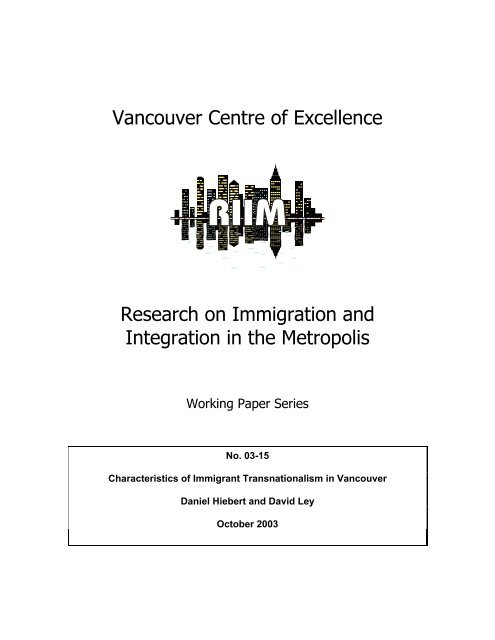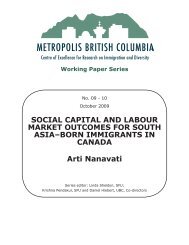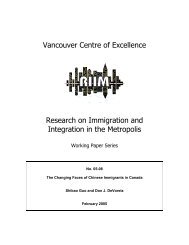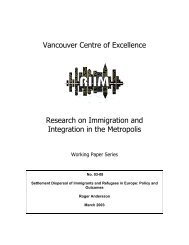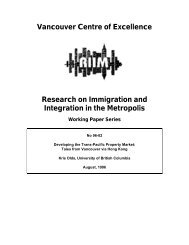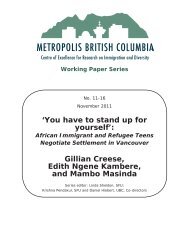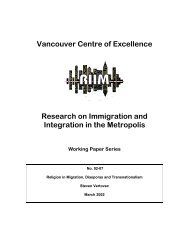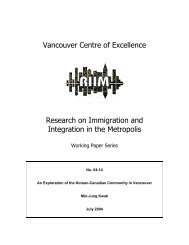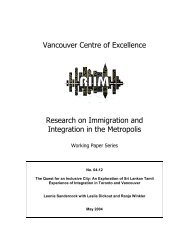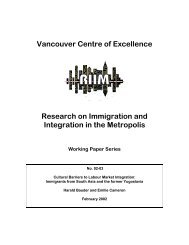Characteristics of Immigrant Transnationalism in ... - Metropolis BC
Characteristics of Immigrant Transnationalism in ... - Metropolis BC
Characteristics of Immigrant Transnationalism in ... - Metropolis BC
Create successful ePaper yourself
Turn your PDF publications into a flip-book with our unique Google optimized e-Paper software.
Vancouver Centre <strong>of</strong> Excellence<br />
Research on Immigration and<br />
Integration <strong>in</strong> the <strong>Metropolis</strong><br />
Work<strong>in</strong>g Paper Series<br />
No. 03-15<br />
<strong>Characteristics</strong> <strong>of</strong> <strong>Immigrant</strong> <strong>Transnationalism</strong> <strong>in</strong> Vancouver<br />
Daniel Hiebert and David Ley<br />
October 2003
RIIM<br />
Research on Immigration and Integration <strong>in</strong> the <strong>Metropolis</strong><br />
The Vancouver Centre is funded by grants from the Social Sciences and<br />
Humanities Research Council <strong>of</strong> Canada, Citizenship & Immigration Canada,<br />
Simon Fraser University, the University <strong>of</strong> British Columbia and the University <strong>of</strong><br />
Victoria. We also wish to acknowledge the f<strong>in</strong>ancial support <strong>of</strong> the <strong>Metropolis</strong><br />
partner agencies:<br />
• Health Canada<br />
• Human Resources Development Canada<br />
• Department <strong>of</strong> Canadian Heritage<br />
• Department <strong>of</strong> the Solicitor General <strong>of</strong> Canada<br />
• Status <strong>of</strong> Women Canada<br />
• Canada Mortgage and Hous<strong>in</strong>g Corporation<br />
• Correctional Service <strong>of</strong> Canada<br />
• Immigration & Refugee Board<br />
Views expressed <strong>in</strong> this manuscript are those <strong>of</strong> the author(s) alone. For more<br />
<strong>in</strong>formation, contact the Co-directors <strong>of</strong> the Centre, Dr. Don DeVoretz,<br />
Department <strong>of</strong> Economics, SFU (e-mail: devoretz@sfu.ca) or Dr. Daniel Hiebert,<br />
Department <strong>of</strong> Geography, U<strong>BC</strong> (e-mail: dhiebert@geog.ubc.ca).
<strong>Characteristics</strong> <strong>of</strong> <strong>Immigrant</strong> <strong>Transnationalism</strong> <strong>in</strong> Vancouver*<br />
by<br />
Daniel Hiebert<br />
Department <strong>of</strong> Geography<br />
University <strong>of</strong> British Columbia<br />
dhiebert@geog.ubc.ca<br />
and<br />
David Ley<br />
Department <strong>of</strong> Geography<br />
University <strong>of</strong> British Columbia<br />
dley@geog.ubc.ca<br />
October 2003<br />
* The authors gratefully acknowledge the f<strong>in</strong>ancial support <strong>of</strong> the Vancouver <strong>Metropolis</strong> centre (RIIM), which<br />
made this research possible. We also thank the other members <strong>of</strong> the Community Studies Survey research team:<br />
Gillian Creese; Isabel Lowe Dyck; Arlene Tiger McLaren; and Gerald<strong>in</strong>e Pratt.
2<br />
Abstract: This is the second <strong>in</strong> a series <strong>of</strong> papers planned on the Vancouver Community Studies<br />
Survey project (see RIIM #03-06 for details). We beg<strong>in</strong> by discuss<strong>in</strong>g the significance <strong>of</strong><br />
transnationalism as an analytical category and survey the literature on the subject. We then consider the<br />
extent and significance <strong>of</strong> transnational activities <strong>in</strong>dicated by 1479 immigrants who took part <strong>in</strong> our<br />
survey and note similarities and contrasts to the results <strong>of</strong> studies undertaken <strong>in</strong> Québec and the USA.<br />
In the Vancouver situation, we f<strong>in</strong>d extensive transnational activities among recent immigrants. Over<br />
time, immigrants appear to ma<strong>in</strong>ta<strong>in</strong> social l<strong>in</strong>kages overseas but the degree <strong>of</strong> economic<br />
transnationalism (e.g., bus<strong>in</strong>ess ownership) lessens.<br />
Key words: transnationalism; immigrants; social surveys; identity; social networks.
3<br />
Introduction<br />
<strong>Transnationalism</strong> is one <strong>of</strong> a series <strong>of</strong> supra-national processes that has been discussed with<strong>in</strong> the<br />
theoretical lens <strong>of</strong> globalisation. If globalisation represents a larger ‘space <strong>of</strong> flows’ that is said to<br />
overrun national borders to shape more expansive regional and global geographies, then transnational<br />
migration is one <strong>of</strong> those flows, the movement <strong>of</strong> labour that accompanies the reconfiguration <strong>of</strong><br />
national economies and societies. Like the movement <strong>of</strong> capital, it seems, labour has now liberated<br />
itself from conta<strong>in</strong>ment with<strong>in</strong> national borders to engage <strong>in</strong> both cont<strong>in</strong>u<strong>in</strong>g movement and<br />
communication between countries <strong>of</strong> orig<strong>in</strong> and dest<strong>in</strong>ation and also to establish a status <strong>of</strong> flexible<br />
identification <strong>in</strong> terms <strong>of</strong> national citizenship.<br />
It is no surprise that transnational migrants touch down at precisely the same sites as John<br />
Friedmann (1986) first identified as the ‘bas<strong>in</strong>g po<strong>in</strong>t’ <strong>of</strong> the new globalis<strong>in</strong>g economy, the global cities<br />
that act as gateways between national societies and the world system. In Canada, Toronto and<br />
Vancouver have emerged as the nation’s two primary w<strong>in</strong>dows on the world. In 2001, they <strong>in</strong>cluded<br />
some <strong>of</strong> the highest proportions <strong>of</strong> the foreign-born anywhere <strong>in</strong> the advanced societies, 43 percent <strong>in</strong><br />
the Toronto census metropolitan area (CMA) and 37 percent <strong>in</strong> the Vancouver CMA. Moreover a<br />
substantial proportion <strong>of</strong> these people are newcomers, land<strong>in</strong>g between 1991 and 2001, amount<strong>in</strong>g to 39<br />
percent <strong>of</strong> the immigrant population <strong>in</strong> Toronto and 44 percent <strong>in</strong> Vancouver. These percentages<br />
translate <strong>in</strong>to large numbers, consist<strong>in</strong>g <strong>of</strong> 792,000 land<strong>in</strong>gs <strong>in</strong> Toronto and 325,000 <strong>in</strong> Vancouver <strong>in</strong><br />
the 1991-2001 period; amongst this recently arrived cohort <strong>in</strong> particular we might expect to see<br />
considerable transnational activity.<br />
The landscapes and social geographies <strong>of</strong> both cities have undergone significant restructur<strong>in</strong>g <strong>in</strong><br />
the past decade. An important development has been the suburbanisation <strong>of</strong> the immigrant population,<br />
no longer conf<strong>in</strong>ed to older <strong>in</strong>ner city reception areas, but now <strong>in</strong>clud<strong>in</strong>g substantial concentrations <strong>in</strong><br />
<strong>in</strong>ner suburbs, where proportions run as high as 54 percent <strong>in</strong> Richmond <strong>in</strong> 2001 and 47 percent <strong>in</strong><br />
Burnaby, compared with a City <strong>of</strong> Vancouver share <strong>of</strong> 46 percent foreign-born (compare Hiebert 1999;<br />
Rose 2001). Moreover the composition <strong>of</strong> immigrant cohorts <strong>in</strong> Vancouver has strongly favoured the<br />
economic classes <strong>of</strong> <strong>in</strong>dependent and bus<strong>in</strong>ess migrants, more so than <strong>in</strong> any other Canadian urban<br />
centre. The high human capital and substantial f<strong>in</strong>ancial assets <strong>of</strong> members <strong>of</strong> these groups have<br />
permitted residential selection <strong>in</strong> the region’s high status districts, <strong>in</strong>clud<strong>in</strong>g the premier neighbourhood<br />
<strong>of</strong> Shaughnessy, where significant landscape change has occurred, lead<strong>in</strong>g to a notable conflict, s<strong>in</strong>ce<br />
resolved, <strong>in</strong> the early 1990s on appropriate hous<strong>in</strong>g and landscape styles (Ley 1995). The impact <strong>of</strong>
4<br />
immigration <strong>in</strong> the Vancouver hous<strong>in</strong>g market more generally has been appreciable; between 1986 and<br />
2001 immigration dom<strong>in</strong>ated population growth and a very high correlation existed between annual<br />
immigration land<strong>in</strong>gs and the movement <strong>of</strong> metropolitan house prices (Ley and Tutchener 2001).<br />
The sett<strong>in</strong>g <strong>of</strong> a gateway city with a large, newly landed population add<strong>in</strong>g to exist<strong>in</strong>g co-ethnic<br />
communities provides a fertile laboratory for transnational behaviour. Case studies have demonstrated<br />
the existence <strong>of</strong> transnational activities among the largest immigrant communities, from Hong Kong<br />
and Taiwan (Waters 2002; Ley and Waters 2003) and from India, particularly the Punjab (Walton-<br />
Roberts 2003). In this chapter we make use <strong>of</strong> a large metropolitan survey <strong>of</strong> 1479 immigrants<br />
conducted <strong>in</strong> 2001 to assess the <strong>in</strong>tensity <strong>of</strong> transnationalism along a number <strong>of</strong> dimensions and to<br />
establish relationships between transnational practices and socio-economic and ethno-cultural<br />
characteristics <strong>of</strong> the population.<br />
<strong>Transnationalism</strong>: the story so far<br />
Soon after Friedmann’s pioneer<strong>in</strong>g discussion <strong>of</strong> global cities followed the early literature on<br />
transnationalism. Anthropologists noted a high density <strong>of</strong> transactions between immigrants to the<br />
United States and relatively proximate home countries like Haiti and the Dom<strong>in</strong>ican Republic <strong>in</strong> the<br />
Caribbean (Glick Schiller et al. 1992), and Central America, notably Mexico (Rouse 1992). This early<br />
work on nearby send<strong>in</strong>g nations has cont<strong>in</strong>ued (Mountz and Wright 1996; Guarnizo 1998; Glick<br />
Schiller and Fouron 1999; Levitt 2001; Pries 2001), and has also expanded to many other regional<br />
sett<strong>in</strong>gs <strong>in</strong>clud<strong>in</strong>g transnational flows between East Asia and North America (Mitchell 1997; Ong and<br />
Non<strong>in</strong>i 1997; Ong 1999; Ley 2000), among countries <strong>in</strong> Asia (Yeoh, Willis and Fakhri 2003), and<br />
between Africa and Europe (Ali-Ali, Black and Koser 2001), amongst others.<br />
Transnational ties have been obscured <strong>in</strong> the past <strong>in</strong> the Canadian literature on ethnicity that has<br />
been based on assimilation or multicultural frameworks, both <strong>of</strong> which have presupposed a model <strong>of</strong><br />
immigrant conta<strong>in</strong>ment with<strong>in</strong> national borders (W<strong>in</strong>land 1998). Recently, however, considerable work,<br />
particularly <strong>in</strong> the Vancouver region, has exam<strong>in</strong>ed transnational ties notably among members <strong>of</strong> the<br />
Ch<strong>in</strong>ese diaspora who have been the lead<strong>in</strong>g s<strong>in</strong>gle immigrant group over the past twenty years<br />
(Mitchell 1997; Wong 1997, 2002; Ley 2000; Waters 2002, 2003; Ley and Waters 2003). Other<br />
contributions have demonstrated the diverse l<strong>in</strong>kages between Greater Vancouver (<strong>in</strong> particular<br />
suburban Surrey) and the Punjab (Walton-Roberts 2003), and also the transnational fields <strong>of</strong> much<br />
smaller groups such as the Burmese (Hyndman and Walton-Roberts 2000). One <strong>of</strong> the few Canadian<br />
studies with a larger sample considered the overseas l<strong>in</strong>kages <strong>of</strong> more than 400 immigrants to Quebec,<br />
<strong>in</strong>clud<strong>in</strong>g the scale <strong>of</strong> home country travel, remittances and property ownership, ten years after land<strong>in</strong>g
5<br />
(Renaud et al. 2002). Several <strong>of</strong> the questions <strong>in</strong> the Quebec study are repeated <strong>in</strong> our Vancouver<br />
survey, and comparative results will be noted later.<br />
As the literature has proliferated, several attempts have been made to take stock <strong>of</strong> the field and<br />
to shape its <strong>of</strong>ten unruly growth (Kearney 1995; Vertovec 1999; Levitt 2001). The <strong>in</strong>terdiscipl<strong>in</strong>ary<br />
nature <strong>of</strong> research has led to methodological debates as sociologists and geographers have entered the<br />
discussion. The early ethnographic work has been challenged, particularly by Portes <strong>in</strong> a series <strong>of</strong><br />
papers, where he argued that the ethnographic approach <strong>of</strong> anthropologists has tended to exaggerate the<br />
<strong>in</strong>cidence <strong>of</strong> transnational behaviour because it has sampled on the dependent variable (Portes,<br />
Guarnizo and Landolt 1999; Portes 2001). Rather than exam<strong>in</strong>e only those cases where transnationalism<br />
may be discerned, there should be broader coverage <strong>of</strong> an entire community that would <strong>in</strong>clude<br />
observations where such activity is lack<strong>in</strong>g. There is grow<strong>in</strong>g recognition that earlier work tended to<br />
overlook the considerable variation both with<strong>in</strong> and between immigrant groups <strong>of</strong> a common nationality<br />
<strong>in</strong> terms <strong>of</strong> their migration strategies on the spectrum from assimilation through multiculturalism to<br />
transnationalism (Ali-Ali, Black and Koser 2001; Wimmer and Glick Schiller 2002). In this respect<br />
Itzigsohn and Saucedo (2002) conclude from a comparative study <strong>of</strong> Lat<strong>in</strong> American groups <strong>in</strong> the USA<br />
that while participation <strong>in</strong> a particular transnational activity may be limited <strong>in</strong> an immigrant population,<br />
there is broad participation across the whole range <strong>of</strong> socio-cultural activities.<br />
Portes and his team have also been sceptical that earlier anthropological studies overemphasized<br />
the novelty <strong>of</strong> transnationalism, although unlike stronger critics (eg. M<strong>in</strong>tz 1998) this does<br />
not lead them to dismiss its conceptual utility. But they do urge a more rigorous approach that seeks<br />
evidence that is measurable rather than anecdotal.<br />
While there is agreement that under transnationalism the relationships between society and<br />
space have been reconfigured (Pries 2001), some authors have gone further to suggest a<br />
deterritorialisation <strong>of</strong> immigrant social fields where a footloose mobility has replaced the importance <strong>of</strong><br />
grounded spatial experience (Ong and Non<strong>in</strong>i 1997; W<strong>in</strong>land 1998). While the mobility <strong>of</strong> transnational<br />
migrants is acknowledged (Waters 2002), this does not mean that space has been eroded as a significant<br />
factor. Follow<strong>in</strong>g a conceptual challenge by Mitchell (1997), other geographers have shown how space<br />
matters, both <strong>in</strong> the effects <strong>of</strong> distance upon family relations and also <strong>in</strong> terms <strong>of</strong> the acute spatial<br />
differentiation made by transnational migrants from East Asia concern<strong>in</strong>g the opportunity structures <strong>of</strong><br />
different nation states (Ley and Waters 2003). In addition, transnational behaviour is strongly grounded<br />
<strong>in</strong> dist<strong>in</strong>ctive spatial clusters <strong>of</strong> ethnic services that facilitate the hyper-mobility <strong>of</strong> astronauts mov<strong>in</strong>g
6<br />
on the ‘Pacific shuttle’ between East Asia and the West Coast <strong>of</strong> North America (Zhou and Tseng<br />
2001).<br />
Survey data with medium- to large-size samples are required to tease out the more<br />
discrim<strong>in</strong>at<strong>in</strong>g relationships required by recent criticisms. While there are relatively few precedents at<br />
present, an important exception is the Comparative <strong>Immigrant</strong> Entrepreneurship Project directed by<br />
Portes and Guarnizo that has undertaken several phases <strong>of</strong> data collection among Colombian,<br />
Dom<strong>in</strong>ican and Salvadoran immigrants <strong>in</strong> four American cities. Their research shows that transnational<br />
entrepreneurs are <strong>of</strong> higher socio-economic status and more likely to be American citizens than foreignborn<br />
wage-earners and entrepreneurs with domestic l<strong>in</strong>kages only (Portes 2001; Landolt 2001).<br />
Transnational entrepreneurs are, <strong>in</strong> general, more satisfied with life <strong>in</strong> the United States and <strong>of</strong> longer<br />
residential duration than the immigrant mean. Moreover immigrants engaged <strong>in</strong> political transactions<br />
with their home countries fit a similar socio-economic pr<strong>of</strong>ile. In this research transnationalism, def<strong>in</strong>ed<br />
by economic and political transactions, emerges as a means <strong>of</strong> successful economic <strong>in</strong>tegration <strong>in</strong> the<br />
United States. While these relationships establish some empirical expectations for our Vancouver<br />
survey, the def<strong>in</strong>ition <strong>of</strong> transnationalism <strong>in</strong> the CIEP would seem to identify the process theoretically,<br />
not as an alternative to assimilation, but as a sub-set <strong>of</strong> assimilation processes (Kivisto 2001).<br />
Methodology<br />
Our results come from a large survey <strong>of</strong> Vancouver residents conducted <strong>in</strong> 2001. The goal <strong>of</strong> the<br />
survey was to gather <strong>in</strong>formation on the experiences <strong>of</strong> immigrants and the attitudes <strong>of</strong> the general<br />
population towards immigration and immigrant settlement. The survey <strong>in</strong>cluded 2000 respondents but<br />
we concentrate <strong>in</strong> this study on the 1479 who were immigrants. 1 Given the uneven settlement pattern <strong>of</strong><br />
immigrants <strong>in</strong> the Vancouver metropolitan area, we opted for a cluster design, with random sampl<strong>in</strong>g<br />
with<strong>in</strong> five target areas that were selected for their dist<strong>in</strong>ct socio-economic pr<strong>of</strong>iles: the east side <strong>of</strong> the<br />
City <strong>of</strong> Vancouver, a work<strong>in</strong>g-class district that has long been associated with multicultural immigrant<br />
settlement; Kerrisdale-Oakridge-Shaughnessy, an upper-middle-class area on the western side <strong>of</strong> the<br />
City <strong>of</strong> Vancouver that has recently become home to relatively affluent immigrants ma<strong>in</strong>ly from eastern<br />
Asia; Richmond, a middle-class suburb immediately south <strong>of</strong> the City <strong>of</strong> Vancouver that is associated<br />
with a large Ch<strong>in</strong>ese-orig<strong>in</strong> population; the Tri-Cities (Coquitlam, Port Coquitlam, and Port Moody),<br />
new middle-class suburbs <strong>in</strong> the northeast quadrant <strong>of</strong> metropolitan Vancouver that has become a<br />
popular dest<strong>in</strong>ation for a mix <strong>of</strong> immigrants, with the largest groups from eastern Asia; and Surrey-
7<br />
Delta, a distant work<strong>in</strong>g-class suburb <strong>in</strong> the southeast quadrant <strong>of</strong> metropolitan Vancouver that houses a<br />
large South Asian population. 2 The survey was conducted by telephone by a specialized market<strong>in</strong>g<br />
company that employed <strong>in</strong>terviewers able to work <strong>in</strong> English plus Canonese, Mandar<strong>in</strong>, Punjabi, H<strong>in</strong>di,<br />
and Tagolog. Most recent immigrants chose to be <strong>in</strong>terviewed <strong>in</strong> their native language while the<br />
opposite was true <strong>of</strong> those who had been settled at least 10 years. Interviews were conducted with an<br />
adult family member who received the call. Consequently <strong>in</strong>terviews <strong>in</strong>cluded family dependents as<br />
well as the pr<strong>in</strong>cipal wage earner. Among the sample 944 were <strong>in</strong> the labour force.<br />
The survey was extensive and covered a variety <strong>of</strong> topics, <strong>in</strong>clud<strong>in</strong>g household and family<br />
structure, employment, <strong>in</strong>come, immigration history, demographic characteristics <strong>of</strong> the respondent<br />
(age, sex, ethnicity, place <strong>of</strong> birth), quality <strong>of</strong> neighbourhood life, perceived discrim<strong>in</strong>ation, attitudes<br />
toward immigration and multiculturalism, citizenship, satisfaction with Canada, and transnational<br />
activities. In this chapter we concentrate on the transnational module <strong>of</strong> the survey, and tabulate results<br />
on this dimension with the socio-economic, demographic, and immigrant status <strong>of</strong> respondents.<br />
Results<br />
We beg<strong>in</strong> with a brief enumeration <strong>of</strong> the answers to ten questions about transnational behaviour (Table<br />
1). As might be expected, a large proportion <strong>of</strong> our respondents have friends and relatives who rema<strong>in</strong><br />
<strong>in</strong> their country <strong>of</strong> orig<strong>in</strong>, and nearly all keep <strong>in</strong> touch with them. Contact <strong>in</strong> most cases takes place<br />
either weekly or monthly, though a small number ma<strong>in</strong>ta<strong>in</strong> daily communication. The vast majority<br />
utilize electronic means <strong>of</strong> communication, especially the telephone, though a high number also uses e-<br />
mail. It appears that the postal system has receded <strong>in</strong> significance, with only one <strong>in</strong> five immigrants<br />
mention<strong>in</strong>g this form <strong>of</strong> communication. 3 Approximately two-thirds <strong>of</strong> those who answered our survey<br />
travel to their pre-migration country. Of those, the majority do so irregularly, less than once a year.<br />
However, one-quarter travel once a year or so, and one <strong>in</strong> five make this journey on a more frequent<br />
basis. There is also considerable <strong>in</strong>teraction <strong>in</strong> the opposite direction: over 60 percent host visitors from<br />
their home country. As before, this travel occurs regularly (at least once per year) for about half <strong>of</strong> the<br />
respondents, and more occasionally for the others.<br />
1 We deliberately oversampled immigrants by approximately double, relative to their proportion <strong>of</strong> the total<br />
population. A detailed discussion <strong>of</strong> the sampl<strong>in</strong>g methodology, <strong>in</strong>clud<strong>in</strong>g a summary <strong>of</strong> the complete survey<br />
<strong>in</strong>strument, can be found <strong>in</strong> Hiebert 2003.<br />
2 Full descriptions <strong>of</strong> these areas can be found <strong>in</strong> Hiebert et al 1998; the social geography <strong>of</strong> immigrant settlement<br />
<strong>in</strong> Vancouver is addressed <strong>in</strong> Hiebert 1999.<br />
3 Respondents were given a list <strong>of</strong> communication methods and asked to identify all that apply. The vast majority<br />
<strong>in</strong>dicated only one or two methods and only two were coded for analysis. The figures <strong>in</strong> the table therefore add up<br />
to more than 100 percent <strong>of</strong> respondents.
8<br />
Table 1: Basic enumeration <strong>of</strong> transnational activities<br />
Yes<br />
No<br />
Question # % # % Refused Total<br />
Family or friends <strong>in</strong> pre-migration country 1332 90.1 143 9.7 4 1479<br />
Do you keep <strong>in</strong> touch with them 1271 95.4 60 4.5 1 1332<br />
How <strong>of</strong>ten<br />
Daily 87 6.8<br />
Weekly 486 38.2<br />
Monthly 524 41.2<br />
Yearly 139 10.9<br />
Less than once a year 23 1.8<br />
Don't know/Refused 12 0.9<br />
Total 1271<br />
How do you keep <strong>in</strong> touch*<br />
E-mail 652 51.3<br />
Telephone 1167 91.8<br />
Postal mail 253 19.9<br />
Visits 302 23.8<br />
Refused 3 0.2<br />
Total 1271<br />
Do you travel to that country 1008 68.2 468 31.6 3 1479<br />
How <strong>of</strong>ten<br />
More than once a year 201 19.9<br />
Once a year or so 238 23.6<br />
Less than once a year 550 54.6<br />
Don't know/Refused 19 1.9<br />
Total 1008<br />
Does your job require you to travel to that country** 48 7.9 555 91.7 2 605<br />
Do you own property there, or have a home 329 22.2 1123 75.9 27 1479<br />
Do you run a bus<strong>in</strong>ess there 47 3.2 1411 95.4 21 1479<br />
Do you provide f<strong>in</strong>ancial assistance to people there 212 14.3 1247 84.3 20 1479<br />
Do family or friends from that country visit you here 903 61.1 567 38.3 9 1479<br />
How <strong>of</strong>ten<br />
More than once a year 123 12.2<br />
Once a year or so 237 23.5<br />
Less than once a year 514 51.0<br />
Don't know/Refused 29 2.9<br />
Total 903<br />
*Respondents were allowed two answers to this question; percentage figures therefore exceed 100.<br />
**676 out <strong>of</strong> 1479 immigrant respondents are currently employed (another 155 are self-employed)<br />
We also asked about economic l<strong>in</strong>ks that facilitate or require transnational connections. Of the<br />
944 respondents <strong>in</strong> the labour market (126 <strong>of</strong> whom were unemployed), only 48 are <strong>in</strong>volved <strong>in</strong> workrelated<br />
travel to their country <strong>of</strong> orig<strong>in</strong>. We were surprised, given the literature on transnationalism, by<br />
the low proportion who answered this question positively. This was also true <strong>of</strong> our question on
9<br />
transnational bus<strong>in</strong>ess ownership; aga<strong>in</strong> just under 50 <strong>of</strong> our respondents operated bus<strong>in</strong>esses <strong>in</strong> their<br />
home countries. 4 A much larger proportion own property abroad, nearly one quarter <strong>of</strong> all respondents.<br />
F<strong>in</strong>ally, on the economic front, around one <strong>in</strong> seven respondents send money to family and friends <strong>in</strong><br />
their pre-migration country.<br />
These basic data on transnationalism reveal a clear pattern already well established <strong>in</strong> the<br />
literature: there is much variation <strong>in</strong> the extent and <strong>in</strong>tensity <strong>of</strong> transnational activity. Some immigrants<br />
presumably do not participate <strong>in</strong> these sorts <strong>of</strong> <strong>in</strong>teractions at all, as they have no family or friends left<br />
<strong>in</strong> their pre-migration country. 5 Also, small numbers <strong>of</strong> our sample have friends and relatives <strong>in</strong> the<br />
home country but make no effort to stay <strong>in</strong> touch with them. There is also what we could call a middlelevel<br />
<strong>of</strong> transnationalism, with occasional visits to and fro mixed with regular electronic contact and,<br />
perhaps, some f<strong>in</strong>ancial <strong>in</strong>terests that stretch across the vast distance that separates pre- and postmigration<br />
contexts. There are also those who, no doubt, answered all, or nearly all, <strong>of</strong> our questions<br />
affirmatively—those who fit the description usually <strong>of</strong>fered <strong>of</strong> cosmopolitan transnationals, who live<br />
lives characterized by geographical fluidity and who identify themselves with at least two places. The<br />
<strong>in</strong>terest<strong>in</strong>g question, <strong>of</strong> course, is, what dist<strong>in</strong>guishes those who ma<strong>in</strong>ta<strong>in</strong> extensive transnational l<strong>in</strong>ks<br />
from those who do not<br />
In the rema<strong>in</strong>der <strong>of</strong> the tables presented <strong>in</strong> this chapter, we focus on the either/or questions<br />
posed to respondents. In each table we cross-tabulate a socio-economic or demographic feature <strong>of</strong> our<br />
sample with eight <strong>in</strong>dicators <strong>of</strong> transnationalism. Cells <strong>in</strong> each table refer to the percentage <strong>of</strong><br />
respondents <strong>in</strong> a particular category (<strong>in</strong> rows) who answered the question (<strong>in</strong> columns) positively. In<br />
construct<strong>in</strong>g these tables, chi-squared tests were conducted to identify statistically significant<br />
relationships. Note that these tests should be seen as <strong>in</strong>structive rather than def<strong>in</strong>itive <strong>in</strong> several cases<br />
where the sample size is quite small. This is particularly the case when deal<strong>in</strong>g with the questions<br />
about job-related transnational travel and transnational bus<strong>in</strong>ess ownership. Also, readers should be<br />
alert to the cases where socio-economic and demographic categories are small, and treat them with a<br />
degree <strong>of</strong> caution.<br />
The first and perhaps most important f<strong>in</strong>d<strong>in</strong>g <strong>of</strong> our study is that the relationship between level<br />
<strong>of</strong> transnationalism and socio-economic status is relatively weak. Our survey <strong>in</strong>cluded questions that<br />
4 Of course this figure must be an underestimate as most migrants with transnational bus<strong>in</strong>ess activities are<br />
overseas for most <strong>of</strong> the year, and would therefore not be at home for a telephone <strong>in</strong>terview.<br />
5 However, it is still possible that they <strong>in</strong>teract regularly with family or friends <strong>in</strong> a third country, an issue not<br />
explored <strong>in</strong> our survey.
10<br />
enabled us to sort respondents on the basis <strong>of</strong> their level <strong>of</strong> education and <strong>in</strong>come. 6 Education is largely<br />
unrelated to the presence or absence <strong>of</strong> family and friends <strong>in</strong> the pre-migration country, as well as the<br />
propensity to keep <strong>in</strong> touch with them and to send them money (Table 2). Surpris<strong>in</strong>gly, education and<br />
the tendency to travel to the home country were also unrelated. There was a significant relationship<br />
between educational atta<strong>in</strong>ment and the tendency to hold property <strong>in</strong> the pre-migration country, but it<br />
was not l<strong>in</strong>ear (that is, those at both the higher and lower ends <strong>of</strong> the educational scale are more likely<br />
than those <strong>in</strong> the middle to hold property—a difficult pattern to expla<strong>in</strong>). The only two associations that<br />
were <strong>in</strong> a predictable direction were between education and the likelihood <strong>of</strong> hold<strong>in</strong>g a bus<strong>in</strong>ess <strong>in</strong> the<br />
pre-migration country on the one hand, and host<strong>in</strong>g visitors from the pre-migration country on the<br />
other. In both cases, those with university degrees and other forms <strong>of</strong> post-secondary education<br />
engaged <strong>in</strong> more transnational activity.<br />
As with education, household <strong>in</strong>come does not appear to be strongly l<strong>in</strong>ked to the level <strong>of</strong><br />
transnational activity (Table 3). It is not surpris<strong>in</strong>g that households across the <strong>in</strong>come spectrum are<br />
about equally likely to have family and friends <strong>in</strong> their home country. However, the fact that there is<br />
little differentiation between high and low <strong>in</strong>come households when it comes to ma<strong>in</strong>ta<strong>in</strong><strong>in</strong>g social<br />
contact as well as economic relationships, is surely more unexpected. Around three percent <strong>of</strong> our<br />
respondents <strong>in</strong> every <strong>in</strong>come category, for example, operate bus<strong>in</strong>esses overseas. Clearly, though,<br />
<strong>in</strong>come is associated with <strong>in</strong>creased travel between Canada and the pre-migration country, <strong>in</strong> both<br />
directions. The level <strong>of</strong> household <strong>in</strong>come is also associated with the propensity to reta<strong>in</strong> property <strong>in</strong><br />
the home country, though not <strong>in</strong> the direction many would expect. Households with the lowest <strong>in</strong>comes<br />
<strong>in</strong> Canada are most likely to hold property abroad, while those with higher <strong>in</strong>comes <strong>in</strong> Canada tend to<br />
give up their overseas land. There are several plausible explanations for this pattern. For example,<br />
those who have not yet found their economic foot<strong>in</strong>g <strong>in</strong> Canada may be hedg<strong>in</strong>g their bets by<br />
ma<strong>in</strong>ta<strong>in</strong><strong>in</strong>g the ability to return, while those who have “made it” <strong>in</strong> Canada might have shifted their<br />
economic activities to this country; or, alternatively, perhaps we are see<strong>in</strong>g the effects <strong>of</strong> “cash rich,<br />
<strong>in</strong>come poor” <strong>in</strong>dividuals who live comfortably <strong>in</strong> Canada while earn<strong>in</strong>g little <strong>in</strong>come—<strong>in</strong> this case<br />
property overseas may provide a source <strong>of</strong> <strong>in</strong>come that is unreported, or underreported, by respondents.<br />
6 Unfortunately, only 1015 <strong>of</strong> the 1479 immigrants <strong>in</strong> our survey provided an answer to our question on household<br />
<strong>in</strong>come. Around one-third <strong>of</strong> those who didn’t answer the question expla<strong>in</strong>ed that they did not know their<br />
household <strong>in</strong>come, while two-thirds simply refused to specify it.
11<br />
Table 2: Transnational activities by level <strong>of</strong> educational atta<strong>in</strong>ment<br />
Family Keep Travel Job Property Bus<strong>in</strong>ess Send $ Visits fr.<br />
<strong>in</strong> home <strong>in</strong> to home requires <strong>in</strong> home <strong>in</strong> home to home home<br />
number* country touch country travel country country country country<br />
12<br />
Table 4: Transnational activities by period <strong>of</strong> land<strong>in</strong>g<br />
Family Keep Travel Job Property Bus<strong>in</strong>ess Send $ Visits fr.<br />
<strong>in</strong> home <strong>in</strong> to home requires <strong>in</strong> home <strong>in</strong> home to home home<br />
number* country touch country travel country country country country<br />
S<strong>in</strong>ce 1991 703 95.4 98.8 64.3 10.9 32.3 5.4 17.2 57.1<br />
Before 1991 773 85.7 92.1 71.9 6.0 13.8 1.2 12.2 65.4<br />
Probability 0.000 0.000 0.002 0.004 0.000 0.000 0.007 0.001<br />
Table 5: Transnational activities by selected immigration class**<br />
Family Keep Travel Job Property Bus<strong>in</strong>ess Send $ Visits fr.<br />
<strong>in</strong> home <strong>in</strong> to home requires <strong>in</strong> home <strong>in</strong> home to home home<br />
number* country touch country travel country country country country<br />
Spouse&Dep. 543 89.5 95.2 67.8 5.0 17.9 2.3 8.4 63.3<br />
Family 292 92.8 95.9 69.9 5.5 29.0 2.4 21.4 48.6<br />
Refugee 41 78.0 81.3 46.3 7.7 22.0 4.9 24.4 41.5<br />
Independent 416 91.5 96.3 67.8 13.5 21.3 3.9 16.9 69.7<br />
Bus<strong>in</strong>ess 55 94.5 100.0 81.8 33.3 38.9 11.1 1.9 80.0<br />
Caregiver 22 85.7 100.0 72.7 0.0 52.4 0.0 33.3 28.6<br />
Other 78 84.6 93.9 65.4 3.8 23.1 3.8 19.2 52.6<br />
Probability 0.063 0.002 0.020 0.080 0.000 0.070 0.000 0.000<br />
* Total number <strong>in</strong> the survey; the number answer<strong>in</strong>g each question is different and less than the total <strong>in</strong>dicated here.<br />
** Classes with fewer than 20 respondents have been omitted<br />
Indicates highest value<br />
Indicates lowest value<br />
Columns pr<strong>in</strong>ted <strong>in</strong> a light tone <strong>in</strong>dicate non-significant results <strong>in</strong> chi-squared tests.<br />
The Canadian immigrant selection system also plays an important role <strong>in</strong> transnational<br />
activities (Table 5). A small number <strong>of</strong> our respondents were admitted under a special program<br />
designed to recruit domestic servants and caregivers to Canada. While our results for this group are not<br />
def<strong>in</strong>itive, they suggest that Live-<strong>in</strong> Caregivers ma<strong>in</strong>ta<strong>in</strong> extensive social and economic l<strong>in</strong>kages with<br />
family and friends <strong>in</strong> their pre-migration country, with the highest rates <strong>of</strong> keep<strong>in</strong>g <strong>in</strong> regular<br />
communication, send<strong>in</strong>g remittances, and reta<strong>in</strong><strong>in</strong>g ownership <strong>of</strong> property. Respondents <strong>in</strong> this<br />
category do not operate bus<strong>in</strong>esses overseas, however, and receive few visitors from their home<br />
countries (though they travel home relatively <strong>of</strong>ten). Bus<strong>in</strong>ess immigrants also exhibit a dist<strong>in</strong>ct pr<strong>of</strong>ile.<br />
As might be expected, they have the highest tendency to operate a bus<strong>in</strong>ess <strong>in</strong> their home country, and<br />
one <strong>in</strong> three engages <strong>in</strong> job-related trans-cont<strong>in</strong>ental travel. In general, this group has the means to<br />
travel and host visitors, and most do so. Nearly all have family and friends overseas and all <strong>of</strong> those<br />
who do ma<strong>in</strong>ta<strong>in</strong> regular contact with them. More than one-third ma<strong>in</strong>ta<strong>in</strong>s property overseas. In
13<br />
contrast to Live-<strong>in</strong> Caregivers, however, bus<strong>in</strong>ess immigrants are very unlikely to send money home,<br />
perhaps because it is not needed given the high socio-economic status <strong>of</strong> this group.<br />
Refugees (aga<strong>in</strong>, a small sub-group <strong>in</strong> our survey) exhibit the opposite pr<strong>of</strong>ile. Given their<br />
flight from dangerous circumstances, refugees have the lowest level <strong>of</strong> contact with family and friends<br />
<strong>in</strong> their home country, and are least likely to travel there. They also receive few visitors from their<br />
home country. However, a fairly high proportion sends money to overseas friends and family.<br />
The largest groups <strong>in</strong>cluded <strong>in</strong> our survey, <strong>in</strong>dependent immigrants, their spouses and<br />
dependents, and family-sponsored immigrants, are fairly similar <strong>in</strong> terms <strong>of</strong> their transnational<br />
activities, which tend to be between the extremes set by refugees on the one hand and bus<strong>in</strong>ess<br />
immigrants on the other. A couple <strong>of</strong> dist<strong>in</strong>guish<strong>in</strong>g features are evident when we look more closely at<br />
differences between these groups: <strong>in</strong>dependent immigrants, as might be expected, are more likely to<br />
engage <strong>in</strong> work-related travel and to operate a bus<strong>in</strong>ess overseas.<br />
There are also pr<strong>of</strong>ound differences <strong>in</strong> transnational activities related to ethnic orig<strong>in</strong> (Table 6).<br />
Those who identified themselves under the general category <strong>of</strong> eastern Asian <strong>in</strong> orig<strong>in</strong>—<strong>in</strong>clud<strong>in</strong>g<br />
Ch<strong>in</strong>ese-, Korean-, and Japanese-Canadians—are, by far, the most transnational <strong>of</strong> our survey<br />
participants. Individuals from these backgrounds ma<strong>in</strong>ta<strong>in</strong> the strongest l<strong>in</strong>ks with family and friends,<br />
travel the most <strong>in</strong> both directions, have the highest tendency to ma<strong>in</strong>ta<strong>in</strong> bus<strong>in</strong>ess <strong>in</strong>terests <strong>in</strong> their home<br />
countries, and engage <strong>in</strong> the most job-related travel. 7 Of course it is worth not<strong>in</strong>g that most <strong>of</strong> the<br />
bus<strong>in</strong>ess immigrants <strong>in</strong> our survey were Ch<strong>in</strong>ese-Canadians.<br />
Table 6: Transnational activities by ethnic orig<strong>in</strong>**<br />
Family Keep Travel Job Property Bus<strong>in</strong>ess Send $ Visits fr.<br />
<strong>in</strong> home <strong>in</strong> to home requires <strong>in</strong> home <strong>in</strong> home to home home<br />
number* country touch country travel country country country country<br />
European/Cadn 421 87.4 93.4 67.4 7.7 10.8 1.7 8.6 70.7<br />
Arab/W Asian 36 88.9 90.6 52.8 0.0 27.8 0.0 19.4 44.4<br />
S Asian 255 85.9 96.8 61.6 1.8 41.2 1.6 16.9 32.5<br />
E Asian 614 93.8 97.0 76.0 13.1 23.9 5.5 12.7 72.7<br />
SE Asian 93 92.5 95.3 54.8 4.8 21.7 3.2 35.9 34.4<br />
Lat<strong>in</strong> Amer/Carib 30 90.0 88.9 50.0 0.0 10.0 0.0 30.0 63.3<br />
Probability 0.002 0.020 0.000 0.099 0.000 0.006 0.000 0.000<br />
7 In many ways this fits the analysis <strong>of</strong> transnationalism <strong>of</strong>fered by Ong (1999).
14<br />
The contrast between those from east Asian backgrounds and those from Lat<strong>in</strong> America and the<br />
Caribbean is particularly sharp. The latter group <strong>of</strong> respondents is small <strong>in</strong> number, but appears to have<br />
relatively modest l<strong>in</strong>ks with home countries (except for remittances). Those <strong>of</strong> European orig<strong>in</strong> are also<br />
less transnational than average, especially when we look at their relative lack <strong>of</strong> economic connections<br />
(property and remittances). This probably reflects several factors: European immigrants <strong>in</strong> our survey<br />
tend to have been <strong>in</strong> Canada longer; they come from more affluent countries where remittances are less<br />
needed; and, possibly, they make more <strong>of</strong> a clear break with their previous economic activities when<br />
migrat<strong>in</strong>g to Canada. Two other groups are dist<strong>in</strong>ctive <strong>in</strong> specific ways: South Asians are by a large<br />
measure most likely to own property <strong>in</strong> their home country (<strong>in</strong> almost all cases this is India); 8 and those<br />
declar<strong>in</strong>g southeast Asian orig<strong>in</strong>s are most likely to send remittances home (this is related to the high<br />
number <strong>of</strong> Filip<strong>in</strong>as who entered Canada as Live-<strong>in</strong> Caregivers).<br />
Table 7: Transnational activities by <strong>in</strong>terview language**<br />
Family Keep Travel Job Property Bus<strong>in</strong>ess Send $ Visits fr.<br />
<strong>in</strong> home <strong>in</strong> to home requires <strong>in</strong> home <strong>in</strong> home to home home<br />
number* country touch country travel country country country country<br />
English 933 87.2 93.5 63.9 6.1 15.8 1.8 14.0 63.1<br />
Cantonese 263 96.2 98.4 84.4 9.7 21.0 3.2 15.7 73.1<br />
Mandar<strong>in</strong> 164 100.0 99.4 72.0 27.9 41.7 12.6 13.2 66.0<br />
Punjabi 109 89.0 99.0 64.2 2.0 57.8 0.9 17.4 15.6<br />
Probability 0.000 0.000 0.000 0.000 0.000 0.000 0.798 0.000<br />
* Total number <strong>in</strong> the survey; the number answer<strong>in</strong>g each question is different and less than the total <strong>in</strong>dicated here.<br />
** Classes with fewer than 20 respondents have been omitted<br />
Indicates highest value<br />
Indicates lowest value<br />
Columns pr<strong>in</strong>ted <strong>in</strong> a light tone <strong>in</strong>dicate non-significant results <strong>in</strong> chi-squared tests.<br />
We can learn more about the Ch<strong>in</strong>ese-orig<strong>in</strong> sub-group by turn<strong>in</strong>g to the language <strong>in</strong> which the<br />
<strong>in</strong>terview took place. Our survey reveals strong differences between immigrants from the Cantonesespeak<strong>in</strong>g<br />
regions <strong>of</strong> southern Ch<strong>in</strong>a and Hong Kong, compared with those from Taiwan and Mandar<strong>in</strong>speak<strong>in</strong>g<br />
parts <strong>of</strong> Ch<strong>in</strong>a (Table 7). Aside from travel, the latter group ma<strong>in</strong>ta<strong>in</strong>s more social and<br />
economic ties with their pre-migration country. Remarkably, every one <strong>of</strong> our 164 Mandar<strong>in</strong>-speak<strong>in</strong>g<br />
respondents has friends and family <strong>in</strong> their home country, and virtually all keep <strong>in</strong> regular contact with<br />
those overseas. They are also far more likely to be <strong>in</strong>volved <strong>in</strong> trans-Pacific work-related travel, and to<br />
own property and bus<strong>in</strong>esses abroad. Cantonese speakers, on the other hand, travel more regularly
15<br />
across the Pacific. Punjabi-speakers tend to hold overseas property, while the fact that they receive few<br />
visitors probably reflects their recent settlement <strong>in</strong> Vancouver and their modest economic means. We<br />
also f<strong>in</strong>d that respondents who felt most comfortable participat<strong>in</strong>g <strong>in</strong> our survey <strong>in</strong> English tend to be<br />
the least transnational.<br />
Table 8: Transnational activities by home language<br />
Family Keep Travel Job Property Bus<strong>in</strong>ess Send $<br />
<strong>in</strong> home <strong>in</strong> to home requires <strong>in</strong> home <strong>in</strong> home to home<br />
number* country touch country travel country country country<br />
English only 330 83.0 92.3 66.0 9.2 9.2 1.2 9.1<br />
English & other 579 91.2 94.5 67.0 7.5 21.3 3.1 17.4<br />
Non-English 567 93.6 98.1 71.1 7.6 32.0 4.5 14.8<br />
Probability 0.000 0.000 0.189 0.167 0.000 0.027 0.003<br />
Does this mean that there is an acculturation effect visible <strong>in</strong> our results We have already seen<br />
that more settled immigrants participate <strong>in</strong> fewer forms <strong>of</strong> transnationalism (though travel is an<br />
exception). Table 8, which divides respondents by their home language, <strong>of</strong>fers some evidence on this<br />
po<strong>in</strong>t. Those respondents who speak a non-English language at home exclusively 9 engage <strong>in</strong> more<br />
<strong>in</strong>tensive transnationalism <strong>in</strong> terms <strong>of</strong> several <strong>of</strong> the activities explored <strong>in</strong> our survey: they keep more<br />
regular contact with family and friends, and are more apt to own property and bus<strong>in</strong>esses <strong>in</strong> their premigration<br />
country. Similarly, those who only speak English <strong>in</strong> their homes are the least transnational<br />
(though a high proportion receive visitors from abroad). However, a careful look at the data<br />
demonstrates that the relationship between home language and transnationalism is far from perfect.<br />
There is <strong>in</strong> fact no statistically significant difference between language groups and their propensity to<br />
travel to home countries either generally or for work. The question on remittances also yielded<br />
ambiguous results. Rather than show<strong>in</strong>g a straightforward acculturation effect, the language data may<br />
reflect the dist<strong>in</strong>ction between European immigrants (who have tended to embrace English as their<br />
home language) and immigrants from other parts <strong>of</strong> the world.<br />
8 It is notable that most <strong>of</strong> the migrants who have moved from India to Vancouver have come from the Punjab<br />
region (Walton-Roberts 2003); moreover, most are Jat caste, or farmers, which helps expla<strong>in</strong> their effort to reta<strong>in</strong><br />
ownership <strong>of</strong> property abroad (see Ba<strong>in</strong>s and Johnston 1995).<br />
9 Respondents were asked to name up to three languages rout<strong>in</strong>ely used <strong>in</strong> their household. Answers to these<br />
questions were coded <strong>in</strong>to the categories employed <strong>in</strong> Table 8.
16<br />
Table 9: Transnational activities by citizenship status<br />
Family Keep Travel Job Property Bus<strong>in</strong>ess Send $<br />
<strong>in</strong> home <strong>in</strong> to home requires <strong>in</strong> home <strong>in</strong> home to home<br />
number* country touch country travel country country country<br />
Canadian only 696 86.5 92.2 69.3 4.5 16.2 1.0 14.5<br />
Canadian and other 339 93.5 98.1 81.4 8.7 15.5 2.4 10.4<br />
Other only 441 93.7 98.3 56.5 14.2 38.6 7.4 17.8<br />
Probability 0.000 0.000 0.000 0.007 0.000 0.000 0.015<br />
* Total number <strong>in</strong> the survey; the number answer<strong>in</strong>g each question is different and less than the total <strong>in</strong>dicated<br />
here.<br />
Indicates highest value<br />
Indicates lowest value<br />
Columns pr<strong>in</strong>ted <strong>in</strong> a light tone <strong>in</strong>dicate non-significant results <strong>in</strong> chi-squared tests.<br />
The argument that transnationalism may dissipate over time, or as circumstances change, is<br />
more apparent when we shift our attention to citizenship status (Table 9). 10 Here the general pattern is<br />
clearer: those who have taken up Canadian citizenship and revoked their orig<strong>in</strong>al citizenship tend to<br />
ma<strong>in</strong>ta<strong>in</strong> fewer transnational ties, whether social or economic. Conversely, those who have not acquired<br />
Canadian citizenship—a mix <strong>of</strong> those who have been <strong>in</strong> Canada less than 4 years; people from countries<br />
that do not allow dual citizenship and who want to reta<strong>in</strong> their orig<strong>in</strong>al citizenship; and those who do<br />
not wish to become Canadian citizens—tend to have the strongest overseas l<strong>in</strong>ks, especially economic<br />
ones. We see the same results when exam<strong>in</strong><strong>in</strong>g the relationship between national identity and<br />
transnationalism (Table 10). Respondents who say that they always “feel Canadian” are less attached to<br />
friends and family <strong>in</strong> the pre-migration country, and ma<strong>in</strong>ta<strong>in</strong> fewer economic l<strong>in</strong>kages. Those who<br />
only occasionally or never feel a Canadian identity are engaged <strong>in</strong> more transnational lifestyles; they<br />
are six times more likely, for example, to operate a bus<strong>in</strong>ess <strong>in</strong> their home country, three times more<br />
likely to own overseas property, and between 1.5 and two times more likely to send remittance<br />
payments. Aga<strong>in</strong>, though, the travel variables are outliers to this pattern: the more respondents feel<br />
attached to Canada, the more they travel to their pre-migration country and the more they host visitors<br />
from it.<br />
10 As <strong>in</strong> the home language case, respondents were asked to name up to three citizenships. These answers were<br />
used to construct Table 9.
17<br />
Table 10: Transnational activities by identification as Canadian<br />
Family Keep Travel Job Property Bus<strong>in</strong>ess Send $<br />
<strong>in</strong> home <strong>in</strong> to home requires <strong>in</strong> home <strong>in</strong> home to home<br />
number* country touch country travel country country country<br />
Always 462 85.4 93.6 71.3 6.8 18.3 1.8 11.2<br />
Most <strong>of</strong> the time 399 91.2 93.4 70.6 7.3 17.0 1.5 13.4<br />
Sometimes 309 93.2 97.9 70.9 3.8 20.0 2.9 18.3<br />
Occasionally 110 93.6 97.1 60.0 20.0 32.7 3.7 21.3<br />
Never 160 95.0 98.7 59.4 16.7 45.9 10.8 15.8<br />
Probability 0.001 0.011 0.001 0.030 0.000 0.000 0.044<br />
* Total number <strong>in</strong> the survey; the number answer<strong>in</strong>g each question is different and less than the total <strong>in</strong>dicated here.<br />
Indicates highest value<br />
Indicates lowest value<br />
Columns pr<strong>in</strong>ted <strong>in</strong> a light tone <strong>in</strong>dicate non-significant results <strong>in</strong> chi-squared tests.<br />
Discussion<br />
We would not expect transnational practices to be the same <strong>in</strong> any two places. Much <strong>of</strong> the American<br />
research has been undertaken <strong>in</strong> southern California and the cities <strong>of</strong> the East Coast. Those migrants are<br />
typically <strong>of</strong> modest means and travel between relatively close orig<strong>in</strong>s <strong>in</strong> Central America and the<br />
Caribbean and their homes <strong>in</strong> the United States. In Vancouver, <strong>in</strong> contrast, recent immigration is<br />
dom<strong>in</strong>ated by sources <strong>in</strong> East Asia, pr<strong>in</strong>cipally Ch<strong>in</strong>a, Hong Kong, Taiwan and Korea, South-east Asia,<br />
notably the Philipp<strong>in</strong>es and Vietnam, and South Asia, pr<strong>in</strong>cipally India. Older migration is from<br />
Europe. Movement between Vancouver and these orig<strong>in</strong>s is long and can only be undertaken by air, an<br />
expensive means <strong>of</strong> transport. Distance and cost are bound to affect the easy movement <strong>of</strong> transnational<br />
migrants.<br />
It is <strong>in</strong>structive to compare the <strong>in</strong>cidence <strong>of</strong> transnational activities <strong>in</strong> Vancouver with a<br />
longitud<strong>in</strong>al panel survey undertaken <strong>in</strong> Montreal (Renaud et al. 2002). In the fourth round <strong>of</strong><br />
<strong>in</strong>terviews with some 300 immigrants ten years after arrival, 96 percent <strong>of</strong> respondents had family <strong>in</strong><br />
their home country, compared with 90 percent <strong>in</strong> Vancouver who specified they had friends or family <strong>in</strong><br />
their home countries. Of the Vancouver sample, 68 percent had travelled to their home country at least<br />
once, close to the Montreal figure <strong>of</strong> 72 percent. There were also surpris<strong>in</strong>gly similar likelihoods <strong>of</strong><br />
own<strong>in</strong>g property <strong>in</strong> the country <strong>of</strong> orig<strong>in</strong> (22 percent <strong>in</strong> Vancouver, 24 percent <strong>in</strong> Montreal), and <strong>of</strong><br />
own<strong>in</strong>g a bus<strong>in</strong>ess there (3.2 percent <strong>in</strong> Vancouver, 2.3 percent <strong>in</strong> Montreal). In contrast remittances<br />
were sent by far fewer Vancouver immigrants, only 14 percent, compared with figures rang<strong>in</strong>g between<br />
28 percent and 67 percent <strong>in</strong> the four rounds <strong>of</strong> the Montreal panel (Renaud et al. 2002).
18<br />
Consider<strong>in</strong>g that more than half the Vancouver respondents had landed <strong>in</strong> Canada more than<br />
ten years before the <strong>in</strong>terview, compared with none <strong>of</strong> the Montreal group, the samples are not<br />
comparable <strong>in</strong> length <strong>of</strong> residence, a variable highly associated with the <strong>in</strong>cidence <strong>of</strong> transnational<br />
activity, nor <strong>in</strong>deed <strong>in</strong> terms <strong>of</strong> immigrant countries <strong>of</strong> orig<strong>in</strong>. Consequently, despite similar pr<strong>of</strong>iles on<br />
several items, it is difficult to know how to <strong>in</strong>terpret the Vancouver-Montreal comparisons, aside from a<br />
few observations. Not surpris<strong>in</strong>gly the different <strong>in</strong>dicators <strong>of</strong> transnationalism reveal marked variations<br />
<strong>in</strong> <strong>in</strong>cidence. With Itzigsohn and Saucedo (2002) we f<strong>in</strong>d that there is broad participation <strong>in</strong><br />
transnational l<strong>in</strong>kages among the immigrant population, though some specific activities, notably<br />
economic transactions, are limited to relatively few. The restriction <strong>of</strong> transnational entrepreneurship to<br />
a small group was also noted by the CIEP assessment <strong>of</strong> Lat<strong>in</strong> American immigrants <strong>in</strong> four American<br />
cities (Portes 2001; Landolt 2001). Travel seems quite different from other <strong>in</strong>dicators, and <strong>in</strong>creases <strong>in</strong><br />
<strong>in</strong>cidence <strong>in</strong> both directions with <strong>in</strong>creas<strong>in</strong>g length <strong>of</strong> residence.<br />
The distance from Vancouver to immigrant orig<strong>in</strong>s is likely a factor here, for cross-tabulations<br />
reveal that it is higher <strong>in</strong>come respondents who are more likely to visit their home countries and receive<br />
visitors from them. There are a few other associations with socio-economic status. Lower-<strong>in</strong>come<br />
immigrants are more likely to report own<strong>in</strong>g property <strong>in</strong> their home countries, as are those report<strong>in</strong>g<br />
lower education levels, while low education atta<strong>in</strong>ment is also associated with an absence <strong>of</strong> homeland<br />
bus<strong>in</strong>ess ownership, and also with receiv<strong>in</strong>g few visitors from home.<br />
But these are the only significant relationships between transnational activities and socioeconomic<br />
status, which emerges as a weak predictor. In contrast the CIEP results showed much<br />
stronger positive associations between transnationalism, socio-economic status and length <strong>of</strong> residence.<br />
Our results are <strong>in</strong> general quite the opposite. Length <strong>of</strong> residence is significantly associated with all <strong>of</strong><br />
our <strong>in</strong>dicators, but aside from the two travel measures, all other <strong>in</strong>dicators show some weaken<strong>in</strong>g with<br />
the passage <strong>of</strong> time. Vancouver immigrants arriv<strong>in</strong>g s<strong>in</strong>ce 1991 are more than four times as likely to<br />
engage <strong>in</strong> transnational bus<strong>in</strong>ess ownership as earlier arrivals, whereas the CIEP f<strong>in</strong>d<strong>in</strong>gs showed a<br />
greater probability <strong>of</strong> transnational entrepreneurship with <strong>in</strong>creas<strong>in</strong>g length <strong>of</strong> residence. Moreover,<br />
while education is positively associated with entrepreneurship, it is seem<strong>in</strong>gly randomly distributed<br />
across different <strong>in</strong>come bands <strong>of</strong> immigrants <strong>in</strong> Vancouver.<br />
In contrast to the weak show<strong>in</strong>g <strong>of</strong> socio-economic status, immigration class and cultural<br />
variables <strong>in</strong> our survey show strong associations with transnational activity. Bus<strong>in</strong>ess class immigrants<br />
expressed the strongest transnational behaviour with high proclivities to ma<strong>in</strong>ta<strong>in</strong> contact and strong<br />
tendencies to engage <strong>in</strong> economic-related travel to their home countries, reflect<strong>in</strong>g the familiar pr<strong>of</strong>ile<br />
<strong>of</strong> the East Asian astronaut household (Ong 1999; Waters 2002). While immigrants with Live-In
19<br />
Caregiver status had m<strong>in</strong>imal bus<strong>in</strong>ess connections home, they too kept <strong>in</strong> close contact (though not<br />
through personal travel), were the most consistent <strong>in</strong> send<strong>in</strong>g remittances home and had the highest<br />
proportion own<strong>in</strong>g property <strong>in</strong> their country <strong>of</strong> orig<strong>in</strong>. Refugees were the second most likely to send<br />
remittances, but otherwise had moderate or low l<strong>in</strong>kages. The rema<strong>in</strong><strong>in</strong>g classes, those land<strong>in</strong>g through<br />
family sponsorship or as <strong>in</strong>dependents (skilled workers) had <strong>in</strong>termediate positions, with skilled<br />
workers predictably express<strong>in</strong>g greater job-related connections, but lower levels <strong>of</strong> remittances and less<br />
property ownership.<br />
The role <strong>of</strong> immigration status, largely <strong>in</strong>dependent <strong>of</strong> socio-economic status, is an important<br />
f<strong>in</strong>d<strong>in</strong>g, but no less relevant were a series <strong>of</strong> ethno-cultural variables, re<strong>in</strong>forc<strong>in</strong>g the view <strong>in</strong> the<br />
literature <strong>of</strong> substantial <strong>in</strong>ter-group (as well as <strong>in</strong>tra-group) variation <strong>in</strong> transnational activity. The<br />
strongest tendency <strong>in</strong> the data was for immigrants from East Asia (Ch<strong>in</strong>a, Hong Kong, Taiwan, Korea)<br />
to exhibit the highest level <strong>of</strong> homeland contact <strong>in</strong> most categories aside from remittances which was<br />
led by South-east Asia (particularly the Philipp<strong>in</strong>es). Mother tongue analysis showed that Mandar<strong>in</strong>speak<strong>in</strong>g<br />
regions (Ch<strong>in</strong>a, Taiwan) were the most transnational. In contrast, English-speak<strong>in</strong>g groups,<br />
and national orig<strong>in</strong>s <strong>in</strong> Europe and (surpris<strong>in</strong>gly) Lat<strong>in</strong> America and the Caribbean had considerably<br />
more limited homeland contact. A consequence <strong>of</strong> these relationships was that groups self-identify<strong>in</strong>g<br />
as non-white (or visible m<strong>in</strong>orities) were more likely to live <strong>in</strong> a transnational field—though these<br />
differentials were not generally as great as those associated with home language.<br />
A f<strong>in</strong>al area <strong>of</strong> <strong>in</strong>terest is the relationship between transnational behaviour and a sense <strong>of</strong><br />
Canadian identity. Aga<strong>in</strong> our results counter those <strong>of</strong> the CIEP data. Respondents who always identified<br />
as Canadian showed low levels <strong>of</strong> transnationalism, other than visits to their homeland and receiv<strong>in</strong>g<br />
visitors from those countries. But all economic l<strong>in</strong>kages (<strong>in</strong>clud<strong>in</strong>g remittances) were very low. These<br />
relationships were significant across all <strong>of</strong> our transnational <strong>in</strong>dicators—suggest<strong>in</strong>g that none <strong>of</strong> them is<br />
trivial <strong>in</strong> differentiat<strong>in</strong>g a sense <strong>of</strong> belong<strong>in</strong>g (though the direction <strong>of</strong> the relationship is reversed for the<br />
two travel items). Relationships were even stronger aga<strong>in</strong>st a question explor<strong>in</strong>g citizenship status,<br />
where the options were Canadian-only, dual citizenship, or non-Canadian status. Indeed citizenship<br />
status was the best predictor <strong>of</strong> all our variables aga<strong>in</strong>st transnational activity. Aside once aga<strong>in</strong> from<br />
the two non-economic travel <strong>in</strong>dicators, all the <strong>in</strong>dicators showed (unlike the CIEP results) that<br />
heightened membership <strong>of</strong> a transnational field limited the probability <strong>of</strong> Canadian citizenship, and by a<br />
marked degree. For example, only 1.0 percent <strong>of</strong> immigrants with Canadian citizenship ran a bus<strong>in</strong>ess<br />
<strong>in</strong> their home country compared with 7.4 percent <strong>of</strong> those without Canadian citizenship; 4.5 percent <strong>of</strong><br />
the former group engaged <strong>in</strong> job-related travel to their country <strong>of</strong> orig<strong>in</strong>, but 14.2 percent <strong>of</strong> the latter.
20<br />
This leads to our pr<strong>in</strong>cipal conclusion: whereas the American research identifies<br />
transnationalism as a form <strong>of</strong> <strong>in</strong>tegration, if not assimilation (Portes 2001; Kivisto 2001; Itzigsohn and<br />
Saucedo 2002), our Vancouver results locate membership <strong>in</strong> a transnational field among immigrants<br />
who are weakly connected to the Canadian nation state. For this group, at least at present,<br />
transnationalism is not a subset <strong>of</strong> <strong>in</strong>tegration, but an alternative to it.<br />
Conclusion<br />
In light <strong>of</strong> the few large surveys <strong>of</strong> transnational behaviour <strong>in</strong> Canada it would be unwise to press a<br />
Canadian-American contrast too far. From our analysis we would concur with the American research<br />
that transnational practices are widely shared <strong>in</strong> such rout<strong>in</strong>e events as ma<strong>in</strong>ta<strong>in</strong><strong>in</strong>g social contact but<br />
are far more restricted when it comes to entrepreneurial transactions. So too there is evidently<br />
considerable variation among national-orig<strong>in</strong> groups <strong>in</strong> their scale <strong>of</strong> activity, and to these differences<br />
we would also add the dist<strong>in</strong>ctive effects <strong>of</strong> class <strong>of</strong> immigrant land<strong>in</strong>g.<br />
But our <strong>in</strong>dicators <strong>of</strong> transnationalism also diverge from the <strong>in</strong>fluential CIEP study <strong>in</strong> important<br />
respects. Our f<strong>in</strong>d<strong>in</strong>gs <strong>in</strong>dicate that transnational entrepreneurs are far more likely to be recent<br />
immigrants and not to hold Canadian citizenship. So too they are not well-specified by socio-economic<br />
status. Our pr<strong>of</strong>ile is closer to the orig<strong>in</strong>al anthropological representation <strong>of</strong> transnationalism as an<br />
alternative to social and economic <strong>in</strong>tegration—a view re<strong>in</strong>forced <strong>in</strong> Vancouver by more focussed<br />
qualitative studies (Ley 2000, Waters 2002)—rather than to the view advanced by Portes and his team<br />
that transnational behaviour is an aid to economic <strong>in</strong>tegration, <strong>in</strong>deed to assimilation, <strong>in</strong> the United<br />
States for well-settled immigrants (Portes 2001, Kivisto 2001).
21<br />
References<br />
Ali-Ali, B., R. Black,, and K. Koser. 2001. The limits to ‘transnationalism’: Bosnian and Eritrean<br />
refugees <strong>in</strong> Europe as emerg<strong>in</strong>g transnational communities. Ethnic and Racial Studies 24:<br />
578-600.<br />
Ba<strong>in</strong>s, T.S. and H. Johnston. 1995. The Four Quarters <strong>of</strong> the Night: The Life-Journey <strong>of</strong> an Emigrant<br />
Sikh. Montreal and K<strong>in</strong>gston: McGill-Queen's University Press.<br />
Friedmann, J. 1986. The world city hypothesis. Development and Change 17: 69-83.<br />
Glick Schiller, N., L. Basch, and C. Blanc-Szanton,. 1992. “<strong>Transnationalism</strong>: A new analytic<br />
framework for understand<strong>in</strong>g migration” Annals <strong>of</strong> the New York Academy <strong>of</strong> Sciences 645: 1-<br />
24.<br />
Glick Schiller, N. and G. Fouron. 1999. Terra<strong>in</strong>s <strong>of</strong> blood and nation: Haitian transnational social fields.<br />
Ethnic and Racial Studies 22: 340-61.<br />
Guarnizo, L. 1998. The rise <strong>of</strong> transnational social formations: Mexican and Dom<strong>in</strong>ican state responses<br />
to transnational migration. Political Power and Social Theory 12: 45-94.<br />
Hiebert, D. 1999. Immigration and the chang<strong>in</strong>g social geography <strong>of</strong> Greater Vancouver. <strong>BC</strong> Studies<br />
121: 35-82.<br />
———. 2003. Are immigrants welcome Introduc<strong>in</strong>g the Vancouver Community Studies Survey. RIIM<br />
Work<strong>in</strong>g Paper #03-06, University <strong>of</strong> British Columbia, Vancouver.<br />
Hiebert, D., G. Creese, I.L. Dyck, T. Hutton, D. Ley, A.T. McLaren, and G. Pratt. 1998. <strong>Immigrant</strong><br />
experiences <strong>in</strong> Greater Vancouver: Focus groups narratives. RIIM Work<strong>in</strong>g Paper #98-15,<br />
University <strong>of</strong> British Columbia, Vancouver.<br />
Hyndman, J. and M. Walton-Roberts. 2000. Interrogat<strong>in</strong>g borders: A transnational approach to refugee<br />
research <strong>in</strong> Vancouver. The Canadian Geographer 44: 244-58.<br />
Itzigsohn, J. and S. Saucedo S. 2002. <strong>Immigrant</strong> <strong>in</strong>corporation and sociocultural transnationalism.<br />
International Migration Review36: 766-98.<br />
Kearney, M. 1995. The local and the global: The anthropology <strong>of</strong> globalization and transnationalism.<br />
Annual Review <strong>of</strong> Anthropology 24: 547-65.<br />
Kivisto, P. 2001. Theoriz<strong>in</strong>g transnational migration: A critical review <strong>of</strong> current efforts. Ethnic and<br />
Racial Studies 24: 549-77.<br />
Landolt, P. 2001. Salvadoran economic transnationalism: Embedded strategies for household<br />
ma<strong>in</strong>tenance, immigrant <strong>in</strong>corporation and entrepreneurial expansion. Global Networks 1: 217-<br />
42.<br />
Levitt, P. 2001. Transnational migration: Tak<strong>in</strong>g stock and future directions. Global Networks<br />
1: 195-216.<br />
Ley, D. 1995. Between Europe and Asia: The case <strong>of</strong> the miss<strong>in</strong>g sequoias. Ecumene 2: 285-310.<br />
———. 2000. Seek<strong>in</strong>g homo economicus: The strange story <strong>of</strong> Canada’s Bus<strong>in</strong>ess Immigration<br />
Program. RIIM Work<strong>in</strong>g Paper #00-02, University <strong>of</strong> British Columbia, Vancouver.<br />
Ley, D. and J. Tutchener. 2001. Immigration, globalisation and house prices <strong>in</strong> Canada’s gateway cities.<br />
Hous<strong>in</strong>g Studies 16: 199-223.
22<br />
Ley, D. and J. Waters. 2003. Between Pentium I and Pentium III environments: Transnational<br />
migration and the geographical imperative. In P. Jackson (ed.) Transnational Spaces. London:<br />
Routledge, <strong>in</strong> press.<br />
M<strong>in</strong>tz, S. 1998. The localization <strong>of</strong> anthropological practice: From area studies to transnationalism.<br />
Critique <strong>of</strong> Anthropology 18: 117-33.<br />
Mitchell, K. 1997. Transnational discourse: Br<strong>in</strong>g<strong>in</strong>g geography back <strong>in</strong>. Antipode 29: 101-14.<br />
Mountz, A. and R. Wright. 1996. Daily life <strong>in</strong> the transnational migrant community <strong>of</strong> San August<strong>in</strong>,<br />
Oaxaca and Poughkeepsie, New York. Diaspora 6: 403-28.<br />
Ong, A. 1999. Flexible Citizenship: The Cultural Logic <strong>of</strong> Transnationality. Durham, NC: Duke<br />
University Press.<br />
Ong, A. and D.Non<strong>in</strong>i (eds.). 1997. Ungrounded Empires: The Cultural Politics <strong>of</strong> Ch<strong>in</strong>ese<br />
<strong>Transnationalism</strong>. New York: Routledge.<br />
Portes, A. 2001. Introduction: the debates and significance <strong>of</strong> immigrant transnationalism. Global<br />
Networks 1: 181-93.<br />
Portes, A., L. Guarnizo, and P. Landolt. 1999. The study <strong>of</strong> transnationalism: Pitfalls and promise <strong>of</strong> an<br />
emerg<strong>in</strong>g research field. Ethnic and Racial Studies 22: 217-37.<br />
Pries, L. 2001. The disruption <strong>of</strong> social and geographic space: Mexican-US migration and the<br />
emergence <strong>of</strong> transnational social spaces. International Sociology 16: 55-74.<br />
Renaud, J., L. G<strong>in</strong>gras, S. Vachon, C. Blaser, J.-F. God<strong>in</strong>, and B. Gagné (à paraître). 2002. What a<br />
difference ten years can make: The settlement experience <strong>of</strong> immigrants admitted to Quebec <strong>in</strong><br />
1989, trad. de Ils sont ma<strong>in</strong>tenant d’ici. Les dix premières années au Québec des immigrants<br />
admis en 1989, Sa<strong>in</strong>te-Foy, Les Publications du Québec.<br />
Rose, J. 2001. Contexts <strong>of</strong> <strong>in</strong>terpretation: Assess<strong>in</strong>g urban immigrant reception <strong>in</strong> Richmond, B.C. The<br />
Canadian Geographer 45: 474-93.<br />
Rouse, R. 1992. Mak<strong>in</strong>g sense <strong>of</strong> settlement: Class formation, cultural struggle and transnationalism<br />
among Mexican migrants <strong>in</strong> the United States. Annals <strong>of</strong> the New York Academy <strong>of</strong> Sciences<br />
645: 25-52.<br />
Vertovec, S. 1999. Conceiv<strong>in</strong>g and research<strong>in</strong>g transnationalism. Ethnic and Racial Studies 22: 447-62.<br />
Walton-Roberts, M. 2003. Transnational geographies: Indian immigration to Canada. The Canadian<br />
Geographer 47: <strong>in</strong> press.<br />
Waters, J. 2002. Flexible families Astronaut households and the experiences <strong>of</strong> lone mothers <strong>in</strong><br />
Vancouver, British Columbia. Social and Cultural Geography 3: 117-34.<br />
———. 2003. Flexible citizens <strong>Transnationalism</strong> and citizenship among economic immigrants <strong>in</strong><br />
Vancouver. The Canadian Geographer 47: <strong>in</strong> press.<br />
Wimmer, A. and N. Glick Schiller. 2002. Methodological nationalism and beyond: Nation-state<br />
build<strong>in</strong>g, migration and the social sciences. Global Networks 2: 301-30.<br />
W<strong>in</strong>land, D. 1998. ’Our home and native land’: Canadian ethnic scholarship and the challenge <strong>of</strong><br />
transnationalism. Canadian Review <strong>of</strong> Sociology and Anthropology 35: 555-77.<br />
Wong, L. 1997. Globalization and transnational migration: A study <strong>of</strong> recent Ch<strong>in</strong>ese capitalist<br />
migration from the Asia Pacific to Canada. International Sociology 12: 329-51.<br />
———. 2002. The emergence <strong>of</strong> small transnational enterprise <strong>in</strong> Vancouver: The case <strong>of</strong> Ch<strong>in</strong>ese<br />
entrepreneur immigrants. International Journal <strong>of</strong> Urban and Regional Research 26: 508-30.
23<br />
Yeoh, B., K. Willis, and S. Fakhri, 2003. Introduction: transnationalism and its edges. Ethnic and<br />
Racial Studies 26: 207-17.<br />
Zhou, Y. and Y-F. Tseng. 2001. Reground<strong>in</strong>g the ‘Ungrounded Empires’: Localization as the<br />
geographical catalyst for transnationalism. Global Networks 1: 131-53.
No. Author(s) Title Date<br />
02-01 Gal<strong>in</strong>a Didukh <strong>Immigrant</strong>s and the Demand for Shelter 01/02<br />
02-02 Abdala Mansour, Nicolas<br />
Marceau and Steeve Mongra<strong>in</strong><br />
Gangs and Crime Deterrence 02/02<br />
02-03 Harald Bauder and Emilie<br />
Cameron<br />
Cultural Barriers to Labour Market Integration: <strong>Immigrant</strong>s<br />
from South Asia and the former Yugoslavia<br />
02-04 Brian Geiger Cloth<strong>in</strong>g Demand for Canadian-born and Foreign-born<br />
Households<br />
02-05 Dan Hiebert Canadian Immigration and the Selection-settlement Services 02/02<br />
Trade-<strong>of</strong>f: Explor<strong>in</strong>g <strong>Immigrant</strong> Economic Participation <strong>in</strong><br />
British Columbia<br />
02-06 David W. Edg<strong>in</strong>gton and<br />
Thomas A. Hutton<br />
Multicultural and Local Government <strong>in</strong> Greater Vancouver 03/02<br />
02-07 Steven Vertovec Religion <strong>in</strong> Migration, Diasporas and <strong>Transnationalism</strong> 03/02<br />
02/02<br />
01/02<br />
02-08 Isabel Dyck Becom<strong>in</strong>g Canadian Girls, Home and School and<br />
Renegotiat<strong>in</strong>g Fem<strong>in</strong><strong>in</strong>e Identity<br />
02-09 Par<strong>in</strong> Dossa Modernization and Global Restructur<strong>in</strong>g <strong>of</strong> Women’s Work:<br />
Border-Cross<strong>in</strong>g Stories <strong>of</strong> Iranian Women<br />
05/02<br />
03/02<br />
02-10 Barry Edmonston Interprov<strong>in</strong>cial Migration <strong>of</strong> Canadian <strong>Immigrant</strong>s 03/02<br />
02-11 Handy Gozalie <strong>Immigrant</strong>s’ Earn<strong>in</strong>gs and Assimilation <strong>in</strong>to Canada’s Labour<br />
Market: The Case <strong>of</strong> Overachievers.<br />
02-12 Isabel Dyck and Arlene Tigar<br />
Mclaren<br />
“I don’t feel quite competent here”: <strong>Immigrant</strong> Mothers’<br />
Involvement with School<strong>in</strong>g<br />
02-13 Gerald<strong>in</strong>e Pratt Between Homes: Displacement and Belong<strong>in</strong>g for Second<br />
Generation Filip<strong>in</strong>o-Canadian Youths<br />
02-14 Kangq<strong>in</strong>g Zhang and Don<br />
DeVoretz<br />
Human Capital Investment and Flows: A Multiperiod Model for<br />
Ch<strong>in</strong>a<br />
04/02<br />
05/02<br />
06/02<br />
07/02<br />
02-15 M<strong>in</strong>elle Mahtani and Alison<br />
Mountz<br />
Immigration to British Columbia: Media Representation and<br />
Public Op<strong>in</strong>ion<br />
02-16 Kathr<strong>in</strong>e Richardson Sieve or Shield NAFTA and its Influence with<strong>in</strong> Cascadia 06/02<br />
08/02<br />
02-17 Don J. DeVoretz, Zhongdong<br />
Ma and Kangq<strong>in</strong>g Zhang<br />
Triangular Human Capital Flows: Some Empirical Evidence<br />
from Hong Kong and Canada<br />
10/02<br />
02-18 Deirdre McKay Filip<strong>in</strong>a Identities: Geographies <strong>of</strong> Social Integration/Exclusion<br />
<strong>in</strong> the Canadian <strong>Metropolis</strong><br />
02-19 Aranzazu Recalde Recent Lat<strong>in</strong> Americans <strong>in</strong> Vancouver: Unyield<strong>in</strong>g Diverse<br />
Needs Versus Insufficient Services<br />
10/02<br />
08/02
No. Author(s) Title Date<br />
02-20 Gillian Creese and Edith Ngene<br />
Kambere<br />
“What Colour is Your English"” 11/02<br />
02-21 Kate Geddie Licence to Labour: Obstacles Fac<strong>in</strong>g Vancouver’s Foreign-<br />
Tra<strong>in</strong>ed Eng<strong>in</strong>eers<br />
11/02<br />
02-22 Bernard Hen<strong>in</strong> and Michelle R.<br />
Bennett<br />
02-23 A. Charlton, S. Duff, D. Grant,<br />
A. Mountz, R.Pike, J. Sohn and<br />
C. Taylor<br />
Immigration to Canada’s Mid-Sized Cities: A Study <strong>of</strong> Lat<strong>in</strong><br />
Americans and Africans <strong>in</strong> Victoria, <strong>BC</strong><br />
The Challenges to Respond<strong>in</strong>g to Human Smuggl<strong>in</strong>g <strong>in</strong> Canada:<br />
Practitioners Reflect on the 1999 Boat Arrivals <strong>in</strong> British<br />
Columbia<br />
12/02<br />
12/02<br />
03-01 David Ley Offsett<strong>in</strong>g Immigration and Domestic Migration I Gateway<br />
Cities: Canadian and Australian Reflections on an ‘American<br />
Dilemma’<br />
01/03<br />
03-02 Don DeVoretz and Kangq<strong>in</strong>g<br />
Zhang<br />
Citizenship, Passports and the Bra<strong>in</strong> Exchange Triangle 01/03<br />
03-03 Johanna L. Waters and S<strong>in</strong> Yih<br />
Teo<br />
03-04 June Beynon, Roumiana Ilieva,<br />
and Marela Dichupa<br />
Social and Cultural Impacts <strong>of</strong> Immigration: An Exam<strong>in</strong>ation <strong>of</strong><br />
the Concept <strong>of</strong> ‘Social Cohesion’ with Implications for British<br />
Columbia<br />
“Do you know your language” How Teachers <strong>of</strong> Punjabi and<br />
Ch<strong>in</strong>ese Ancestries Construct their Family Languages <strong>in</strong> their<br />
Personal and Pr<strong>of</strong>essional Lives<br />
01/03<br />
01/03<br />
03-05 Daniel Hiebert, Jock Coll<strong>in</strong>s,<br />
and Paul Spoonley<br />
Uneven Globalization: Neoliberal Regimes, Immigration, and<br />
Multiculturalism <strong>in</strong> Australia, Canada, and New Zealand<br />
03-06 Daniel Hiebert Are <strong>Immigrant</strong>s Welcome Introduc<strong>in</strong>g the Vancouver<br />
Community Studies Survey<br />
03-07 Yan Shi The Impact <strong>of</strong> Canada’s Immigration Act on Ch<strong>in</strong>ese<br />
Independent <strong>Immigrant</strong>s<br />
03-08 Roger Andersson Settlement Dispersal <strong>of</strong> <strong>Immigrant</strong>s and Refugees <strong>in</strong> Europe:<br />
Policy and Outcomes<br />
03-09 Daniel Hiebert and Ravi<br />
Pendakur<br />
03-10 Serviy Pivnenko and Don<br />
DeVoretz<br />
03-11 Don J. DeVoretz, Sergiy<br />
Pivnenko, Diane Coulombe<br />
03-12 David W. Edg<strong>in</strong>gton, Michael<br />
A. Goldberg,and Thomas A.<br />
Hutton<br />
03-13 Margaret Walton-Roberts and<br />
Gerald<strong>in</strong>e Pratt<br />
Who’s Cook<strong>in</strong>g The Chang<strong>in</strong>g Ethnic Division <strong>of</strong> Labour <strong>in</strong><br />
Canada, 1971-1996<br />
Economic Performance <strong>of</strong> Ukra<strong>in</strong>ian <strong>Immigrant</strong>s <strong>in</strong> Canada and<br />
the United States<br />
The <strong>Immigrant</strong> Triangle: Québec, Canada and the Rest <strong>of</strong> the<br />
World<br />
02/03<br />
03/03<br />
04/03<br />
03/03<br />
03/03<br />
03/03<br />
05/03<br />
The Hong Kong Ch<strong>in</strong>ese <strong>in</strong> Vancouver 04/03<br />
Mobile Modernities: One South Asian Family Negotiates<br />
Immigration, Gender and Class<br />
03-14 Leonie Sandercock Reth<strong>in</strong>k<strong>in</strong>g Multiculturalism for the 21 st Century 10/03<br />
09/03
For <strong>in</strong>formation on papers previous to 2002, please see our Website<br />
http://www.riim.metropolis.net/research/policy<br />
Back issues <strong>of</strong> work<strong>in</strong>g papers are available for $5 from<br />
Vancouver Centre <strong>of</strong> Excellence: Immigration, WMX4653, Simon Fraser University, 8888 University<br />
Drive, Burnaby, B.C, Canada V5A 1S6. Tel: (604) 291-4575 Fax: (604) 291-5336<br />
E-mail: riim@sfu.ca<br />
http://www.riim.metropolis.net/


